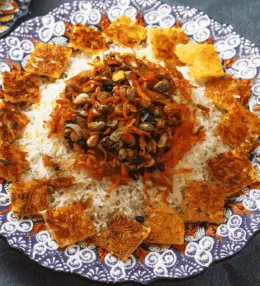
- View
Table of Contents
ToggleImagine a dish that smells of palm sugar and coconut milk, carrying smells of slow cooked spices with every spoonful. Gudeg is one of those iconic Javanese foods that instantly reveals the warm, layered spirit of Indonesian home cooking. Its roots run deep in the old streets of Yogyakarta, where it continues to be a comforting daily meal.
This sweet jackfruit stew has a subtle complexity that surprises anyone expecting just fruit flavours. Its gentle sweetness, creamy coconut undertone, and delicate spices bring a quiet satisfaction to the palate. It is not a meal that shouts; instead, it wraps you in its earthy comfort with quiet confidence.
Want to dive deeper into Indonesian Cuisine? Don’t miss our post on 31 Traditional Indonesian Foods to Try
What Is Gudeg?
Gudeg is a traditional Javanese stew made from young unripe jackfruit simmered gently for hours until it turns a rich brown and absorbs the flavours around it. It is often served with rice, boiled eggs, chicken, or tofu, creating a full meal that fills both body and spirit.
The dish is deeply rooted in Yogyakarta, earning it the affectionate title of Kota Gudeg or Gudeg City. Locals prepare it as an everyday food, yet it is also presented on special occasions to honour guests with something that feels like home on a plate.
Ingredients and Taste
The key ingredient is young jackfruit, known locally as nangka muda. It is simmered with coconut milk, palm sugar, bay leaves, galangal, and teak leaves, which give it that deep earthy brown colour. The result is a dish that balances sweetness with a hint of savoury undertones.
Unlike jackfruit in desserts, Gudeg’s sweetness comes from palm sugar and long simmering rather than the fruit’s own sugars. The coconut milk adds creaminess, while galangal and bay leaves bring a subtle herbal aroma. It is mild, comforting, and not spicy at all.
Teak leaves are used traditionally to give Gudeg its reddish brown hue. Where these are unavailable, locals substitute with black tea to achieve similar colouring. The dish is usually accompanied by a hard-boiled egg cooked in the same rich stew and pieces of tender chicken.
Served with rice and a spoonful of spicy sambal krecek made from crispy beef skin, Gudeg becomes a meal that combines sweet, creamy, savoury, and spicy in one plate. Each bite offers an earthy sweetness balanced by salt and gentle heat on the side.
A Taste of History
Gudeg’s origins are deeply tied to Yogyakarta’s culture. The dish emerged during the Mataram Kingdom era, when young jackfruit was abundant and formed a practical yet delicious food base for locals. It grew into a staple cooked in every household over firewood stoves.
In earlier days, Gudeg was cooked in clay pots over a slow fire. This method allowed the flavours to meld, creating its signature rich and mellow sweetness. The long cooking time was not just culinary preference but practicality, as it preserved the dish longer in a tropical climate.
As time passed, Gudeg became associated with the city’s identity. Street stalls and traditional warungs serve it to this day, each claiming secret spice blends passed through generations. Locals often enjoy it as breakfast, though it is eaten any time of day.
Today, Gudeg is not merely food; it is a story of Javanese patience and culinary artistry. For visitors to Yogyakarta, it is a must-try that offers more than flavour. It carries the warmth of a community that values balance, subtlety, and a touch of sweet comfort in daily life.
How to make Indonesian Gudeg
Gudeg is a treasured dish from Yogyakarta, simmering young jackfruit in coconut milk and aromatic spices until deeply caramelised and tender. Expect a gentle sweetness balanced with earthy notes of teak leaves or tea, infusing the stew with its signature reddish hue. Prepare for slow cooking that rewards with unforgettable Javanese comfort. See the recipe card at the bottom for printable directions
Ingredients
For the Gudeg Stew
- 1 kg young green jackfruit (canned in brine, drained and cut into chunks)
- 400 ml coconut milk
- 4 boiled eggs, peeled
- 200 g palm sugar, roughly chopped
- 8 shallots, peeled
- 6 cloves garlic, peeled
- 4 candlenuts (or substitute with macadamia nuts)
- 5 cm galangal, peeled and sliced
- 3 cm ginger, peeled
- 3 Indonesian bay leaves (daun salam)
- 4 kaffir lime leaves
- 1 tbsp coriander seeds
- 1 tsp salt
- 1 tsp ground white pepper
- 1 tbsp tamarind paste
- 2 black tea bags (or a handful of dried teak leaves for traditional colour)
- 1 litre water
Cooking Instructions
Step 1: Prepare the Spice Paste
To begin, blend shallots, garlic, candlenuts, ginger, and coriander seeds into a fine paste using a food processor. Add a splash of water if needed to achieve a smooth texture. This aromatic base defines the depth of flavour.
Step 2: Arrange the Ingredients
In a large heavy bottomed pot, place teak leaves or tea bags at the base. Layer the jackfruit chunks on top. Scatter the sliced galangal, bay leaves, kaffir lime leaves, and pour the spice paste evenly over the jackfruit to infuse every piece.
Step 3: Add Coconut Milk and Seasoning
Pour in coconut milk and 1 litre of water, ensuring the jackfruit is submerged. Add palm sugar, tamarind paste, salt, and white pepper. Stir gently to distribute seasonings without breaking the jackfruit chunks.
Step 4: Add the Eggs
Nestle the peeled boiled eggs into the mixture. They will absorb the sweet and spiced broth, adding richness to the final dish.
Step 5: Simmer the Gudeg
Cover the pot with a lid and bring to a gentle boil over medium heat. Once boiling, reduce to low and let it simmer uncovered for 4-5 hours. Occasionally baste the jackfruit with the liquid to keep it moist and richly coloured.
Step 6: Reduce and Caramelise
As it cooks, allow the liquid to reduce significantly until the coconut milk turns oily and the jackfruit darkens to a rich reddish brown. Stir gently to prevent sticking. This slow caramelisation develops Gudeg’s signature taste.
Step 7: Check for Seasoning
Taste the sauce towards the end of cooking. Adjust salt or add a touch more palm sugar if needed to balance the sweetness and savoury depth.
Step 8: Remove Teak Leaves or Tea Bags
Once cooked, carefully remove the teak leaves or tea bags. They will have released their colour and tannins, no longer needed in the final presentation.
Step 9: Rest Before Serving
Turn off the heat and let the Gudeg sit for at least 15 minutes. This allows flavours to settle and deepen further, enhancing the eating experience.
Final Step: Serve and Garnish
Transfer to a serving bowl, placing eggs on top. Traditionally enjoyed with steamed rice, krecek (spicy stewed cattle skin crackers), and sambal for a true Yogyakarta feast. Garnish with fried shallots for added aroma and texture.
Variations and Substitutions
- Substitute candlenuts with macadamia nuts if unavailable.
- Replace teak leaves with strong black tea bags for colour.
- For a vegetarian version, omit eggs and serve with tempeh or tofu braised in the same broth.
Cooking Tips for Perfect Gudeg
- Use canned young jackfruit in brine, not syrup, to maintain savoury flavour.
- Do not rush the cooking time; long simmering develops deep caramel notes.
- Stir gently to keep jackfruit pieces intact and beautiful in presentation.
- Cook a day ahead for enhanced flavour as Gudeg tastes better the next day.
- Pair with coconut rice to heighten the richness of the stew.

Indonesian Gudeg (Sweet Jackfruit Stew)
Ingredients
- 1 kg young green jackfruit canned in brine, drained and cut into chunks
- 400 ml coconut milk
- 4 boiled eggs peeled
- 200 g palm sugar roughly chopped
- 8 shallots peeled
- 6 cloves garlic peeled
- 4 candlenuts or substitute with macadamia nuts
- 5 cm galangal peeled and sliced
- 3 cm ginger peeled
- 3 Indonesian bay leaves daun salam
- 4 kaffir lime leaves
- 1 tbsp coriander seeds
- 1 tsp salt
- 1 tsp ground white pepper
- 1 tbsp tamarind paste
- 2 black tea bags or a handful of dried teak leaves for traditional colour
- 1 litre water
Instructions
- To begin, blend shallots, garlic, candlenuts, ginger, and coriander seeds into a fine paste using a food processor. Add a splash of water if needed to achieve a smooth texture. This aromatic base defines the depth of flavour.
- In a large heavy bottomed pot, place teak leaves or tea bags at the base. Layer the jackfruit chunks on top. Scatter the sliced galangal, bay leaves, kaffir lime leaves, and pour the spice paste evenly over the jackfruit to infuse every piece.
- Pour in coconut milk and 1 litre of water, ensuring the jackfruit is submerged. Add palm sugar, tamarind paste, salt, and white pepper. Stir gently to distribute seasonings without breaking the jackfruit chunks.
- Nestle the peeled boiled eggs into the mixture. They will absorb the sweet and spiced broth, adding richness to the final dish.
- Cover the pot with a lid and bring to a gentle boil over medium heat. Once boiling, reduce to low and let it simmer uncovered for 4-5 hours. Occasionally baste the jackfruit with the liquid to keep it moist and richly coloured.
- As it cooks, allow the liquid to reduce significantly until the coconut milk turns oily and the jackfruit darkens to a rich reddish brown. Stir gently to prevent sticking. This slow caramelisation develops Gudeg’s signature taste.
- Taste the sauce towards the end of cooking. Adjust salt or add a touch more palm sugar if needed to balance the sweetness and savoury depth.
- Once cooked, carefully remove the teak leaves or tea bags. They will have released their colour and tannins, no longer needed in the final presentation.
- Turn off the heat and let the Gudeg sit for at least 15 minutes. This allows flavours to settle and deepen further, enhancing the eating experience.
- Transfer to a serving bowl, placing eggs on top. Traditionally enjoyed with steamed rice, krecek (spicy stewed cattle skin crackers), and sambal for a true Yogyakarta feast. Garnish with fried shallots for added aroma and texture.
Nutrition
You May Also Like







Leave a Review